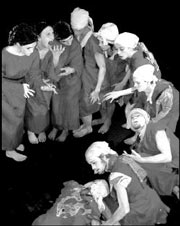5000 FALLING SOULS
Dappin’ Butoh Chamber Theater, 915 E. Pine, 4th floor, 526-5756, $14 8 p.m. Thurs., May 16- Sat., May 18
BUTOH WAS CREATED in the aftermath of human tragedy, as a response to the devastation of postwar Japan. Early practitioners were looking for a Japanese equivalent of American modern dance that would reflect the specificity of their Asian aesthetics and heritage. Given this history, it might seem almost too appropriate for Joan Laage, director of the Seattle-based Dappin’ Butoh company, to make a work dealing with Sept. 11, but when the choreographer found herself coincidentally traveling to New York City last October, there didn’t seem to be any choice in the matter. In the sights and smells of that trip, Laage found the genesis for 5000 Falling Souls.
The title refers to an image taken from Buddhist mythology of “hungry ghosts” and the thousands of people whose lives ended in a rush of collapsing architecture last autumn. The work moves almost literally from images of fire and pain to a kind of rarefied acceptance. But the power of Souls is generated by the accumulation of tableaux rather than the through line of a plot or the ongoing development of movement phrases.
Members of the ensemble take on different attitudes or qualities, almost like miniature emotional states, as if snapshots of the dead are being projected for the audience to witness. At times they seem tender, pompous, silly, avaricious, or any one of myriad other characteristics. The actual dancing is relatively simple—the resonance comes from the nuances laid over it.
A trio of women first appears in a kind of group costume, with connecting sleeves creating a macabre version of “Ring Around the Rosie.” They return throughout the work, mostly dancing separately from the ensemble, eventually dressed in multiple layers of gauzy white kimonos. At times they resemble a supernatural force, rather like the three fates, but elsewhere they seem only to comment on the action, not to control it. The ensemble itself can also seem like one giant organism, oozing or tumbling through the space. One of the hallmarks of butoh is its use of ultraslow timing, so that a simple walk across the stage can take several minutes and encompass several different characters or emotions. Even during quicker passages, the style has a deliberate and inevitable quality, like a natural force come into the theater.
Video artist Scott Johnson and lighting designers Dave Proscia and Lily Nguyen have created a beautiful and disquieting environment for the dance. Images of clouds, flames, and moving water are projected onto the side curtains, with dappled light playing over the rest of the stage, creating a sense of mild agitation even while the performers are still. Martial artist Restita de Jesus appears intermittently as a kind of protective figure, but her slicing movement, direct focus, and powerful attack are almost too distinct from the rest of the cast, distancing her from their environment. By the end of the work, we feel that the gentle trio has had more effect on the group, and as the women allow themselves to be petted and pushed by the ensemble, they seem to be offering themselves as a kind of sacrifice for their colleagues.
Over the next months and years, we will see many different kinds of art trying to help make sense of senseless actions. 5000 Falling Souls is a thoughtful and respectful contribution to that difficult task.








